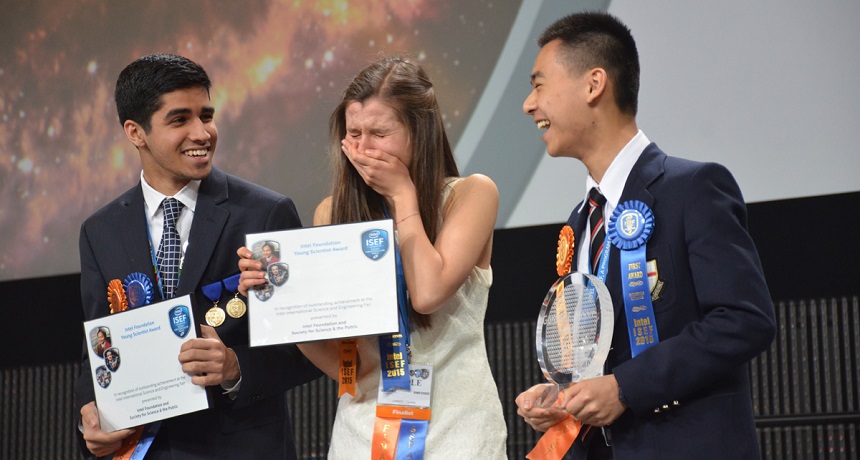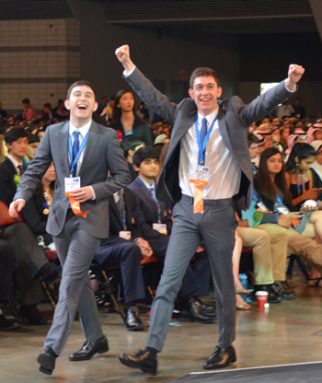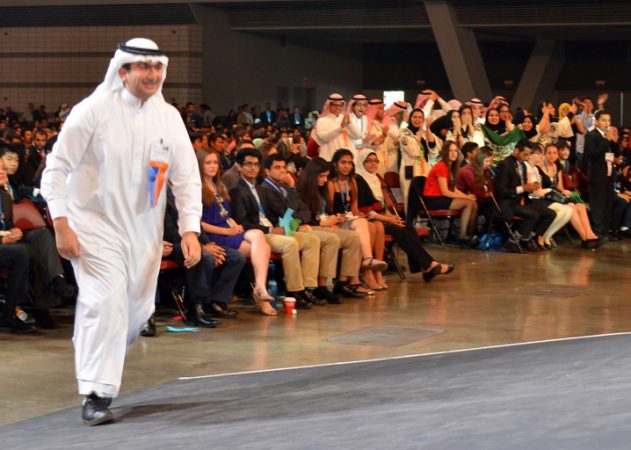Teens win big for pollution control and HIV detection
The top winners in the 2015 Intel ISEF competition designed techniques to improve air quality in aircraft cabins, to diagnose HIV early and to corral oil spills

The trio of top winners at the 2015 Intel ISEF competition, from left: Karan Jerath of Friendswood, Texas, with Nicole Ticea and Raymond Wang of Vancouver, Canada.
L. Buitrago/SSP
Share this:
- Share via email (Opens in new window) Email
- Click to share on Facebook (Opens in new window) Facebook
- Click to share on X (Opens in new window) X
- Click to share on Pinterest (Opens in new window) Pinterest
- Click to share on Reddit (Opens in new window) Reddit
- Share to Google Classroom (Opens in new window) Google Classroom
- Click to print (Opens in new window) Print
By Sid Perkins
PITTSBURGH, Pa. — Airline passengers, breathe easy. New research to help improve the air quality inside planes is getting ready for takeoff. A 17-year-old’s design for rerouting the airflow in planes claimed the $75,000 top prize at this year’s Intel International Science and Engineering Fair, or ISEF. One day the devices could reduce the transmission of disease among passengers.
Two other teen researchers earned awards of $50,000 each at the event. One developed a technique to more quickly diagnose infections by HIV. It’s the virus responsible for AIDS. The other invented a device to more quickly shut down undersea oil spills.
Those awards represent just a fraction of the roughly $4 million handed out here on May 15. Intel ISEF attracts some of the world’s best and brightest teen researchers. Launched in 1950 and now sponsored by Intel Corp., ISEF is a program of Society for Science & the Public. (SSP is also the parent organization of Science News for Students.) This year, 1,702 high-school finalists participated. They represented 422 affiliate science fairs in 78 countries, regions and territories. More than one-third of the finalists received an award here for their research.

From these data, he designed a low-cost deflector. The device easily could be installed in an aircraft’s ventilation system. Today, much of the flow of air tends to move around the cabin at nose level, Raymond notes. His adaptation instead would send the air downward. This would blow the germs from sneezes and coughs toward the floor. That simple change should reduce the numbers of germs inhaled by passengers by more than 98 percent, according to Raymond’s calculations. Also, the deflector should almost triple the amount of fresh air available to passengers.
“I’ve been to many science fairs, but this is my first time at ISEF,” said Raymond, just minutes after receiving his award. “There’s nothing else like it. And I’m really surprised that I won.”
Two other researchers — Nicole Ticea, 16, of Vancouver, Canada, and Karan Jerath, 18, of Friendswood, Texas — each received Intel Foundation Young Scientist Awards. These awards are each worth $50,000.
Nicole, 16, is a junior at York House School. She developed a low-cost, easy-to-use device that can test small samples of blood. It can reveal early signs of infection with HIV. This germ attacks a person’s immune system. Left untreated, HIV infection can become fatal. Nicole’s new test offers hope of quick detection. It could uncover the virus as soon as one week after a person has become infected.
Test results also would be available in about an hour. That’s important. Quick diagnoses can help reduce the numbers of patients who don’t realize they can infect others. Plus, the teen explains, the earlier a patient’s infection is detected, the quicker treatment can begin.
Karan is an 18-year-old senior at Friendswood High School. He designed a sturdy device that can collect the oil, gas and water spewing from a broken well on the seafloor. Sensors inside the 350-ton device would measure the temperature, pressure and density of the mix of gases and fluids erupting from a well. A computer would then calculate how valves in the gadget should be adjusted so that the gas and oil can be collected. That should stop a spill in its tracks, says Karan. The device could help prevent an ecological catastrophe. It also would reduce cleanup costs, he adds.

“Intel believes young people are the key to future innovation,” says Wendy Hawkins. She’s executive director of the Intel Foundation, which is based in Hillsboro, Ore. “We hope these winners will inspire other young people to pursue their interest in these fields,” she says, “and apply their curiosity, creativity and ingenuity to the common good.”
The competition’s top three awards are certainly great, but 19 other students were offered college scholarships at Intel ISEF that are at least as valuable. Drexel University in Philadelphia offered full scholarships — worth up to $150,000 — to Paige Brown, 16, of Bangor, Maine; Aidan Dwyer, 17, of Northport, N.Y.; Shixuan Li, 17, of Panama City, Fla.; Ava Lakmazaheri, 17, of Alexandria, Va.; Blandon Su, 17, of Lincolnshire, Ill.; Maya Varma, 16, of San Jose, Calif.; Craig Worley, 17, of Locust Grove, Ga.; and Bo You, 17, of Miami, Fla. Florida Institute of Technology in Melbourne, extended similar $150,000 scholarships to Carolyn Jons, 17, of Eden Prairie, Minn.; Alexis Hopkins, 16, of Fort Walton Beach, Fla.; and Elise Paietta, 17, of Dayton, Ohio. West Virginia University in Morgantown offered $50,000 scholarships to Kendall Clark, 17, of Bushnell, Fla.; Nathanael Freeman, 17, of Chillicothe, Ohio; Trevor Jordan, 17, of Durango, Colo.; Ralph Lawton, 16, of West Chester, Pa.; Robert Phillips, 17, of Inwood, W. Va.; Brynn Myers, 16, of Oak Ridge, Mo.; Vidur Prasad, 16, of Kettering, Ohio; and Anisha Valluri, 17, of Ona, W. Va.
Topical awards
Like Raymond, Nicole and Karan, 17 other students also picked up awards worth $5,000 for having the top project in their categories. They include:
animal sciences: Nattapong Chueasiritaworn, 15; Thananon Hiranwanichchakorn, 16; and Sutthiluk Rakdee, 15, who attend Damrongratsongkroh in Muang, Thailand. Their project produced silk from silkworms without killing them.
behavioral and social science: Sophia Korner, 16, and Diya Mathur, 16, who attend DuPont Manual High School in Louisville, Ky. Their project focused on human perceptions of the forces needed to lift weights of various sizes and shapes.
biochemistry: Amol Punjabi, 16, who attends the Massachusetts Academy of Math and Science in Worcester. He developed computer models that simulate how certain proteins behave inside human cells.
cellular and molecular biology: Demetri Maxim, 17, who attends Gould Academy in Bethel, Maine. He found a way to transform certain types of human stem cells into kidney cells.
chemistry: Arne Hensel, 18, who attends Bundesprasident Theodor Heuss School in Homburg/Efze, Germany. He created a method to create glowing displays by adding organic dyes to aluminum oxide coatings on objects.
computational biology and bioinformatics: Twin brothers Michael and Matthew Retchin, 17, who attend Mills E. Godwin High School in Richmond, Va. They developed software that efficiently analyzed how certain fragments of genetic material in liver cancer cells interact with a wide variety of proteins.
earth and environmental sciences: Joshua Zhou, 16, who attends East Chapel Hill High School in Chapel Hill, N.C. He invented a material to destroy certain pollutants as they flow across a surface and are exposed to light.
embedded systems: Niklas Fauth, 17, who attends Friedrich Schiller Gymnasium in Marbach am Neckar, Germany. He created a sensor that can analyze the concentrations of gases in a mixture.
energy – chemical: Kathy Liu, 16, who attends West High School in Salt Lake City, Utah. She built a solid-state battery (one that doesn’t include acids or flammable liquids) that can hold a charge after being recharged 1,000 times.
energy – physical: Sriharshita Musunuri, 15, who attends Henry M. Jackson High School in Mill Creek, Wash. She discovered a mix of materials that will enable engineers to generate electricity using the waste heat from industrial processes.
materials science: Catherine Li, 18, who attends Lake Highland Preparatory School in Orlando, Fla. She studied how to use tiny particles of biodegradable polymers to deliver drugs to diseased cells.
mathematics: Sanath Devalapurkar, 15, who attends West High School in Torrance, Calif. He found a way to preserve information during the transformation of one large set of numbers into another.
microbiology: Carly Crump, 18, who attends the Episcopal School of Jacksonville in Florida. She identified proteins in mosquito cells that appear to be involved in the transmission of dengue virus.
physics and astronomy: Ruochen Hao, 17, who attends Shandong Experimental High School in Jinan, China. He analyzed how horseshoe bats use their ears to scan their surroundings during echolocation.
plant sciences: Abduljabbar Alhamood, 18, who attends Dhahran Schools in Dhahran, Saudi Arabia. He found a possible way to genetically modify a variety of plants, including important crops, on a temporary basis.
robotics and intelligent machines: Ava Lakmazaheri, 17, who attends Thomas Jefferson High School for Science and Technology in Alexandria, Va. She created robotic equipment that can be controlled by a disabled patient’s brain waves.
systems software: Charles Noyes, 16, who attends Villa Park High School in California. He created anti-virus software that’s quicker and more effective than commercial programs now available.
The Intel ISEF finalists are all “talented young students,” says Ajmera of SSP. She says they are “the problem solvers and innovators of their generation.”
Power Words
(for more about Power Words, click here)
AIDS (short for Acquired Immune Deficiency Syndrome) A disease that weakens a body’s immune system, greatly lowering resistance to infections and some cancers. It is caused by the HIV germ. (See also HIV)
cancer Any of more than 100 different diseases, each characterized by the rapid, uncontrolled growth of abnormal cells. The development and growth of cancers, also known as malignancies, can lead to tumors, pain and death.
computer model A program that runs on a computer that creates a model, or simulation, of a real-world feature, phenomenon or event.
dengue fever A potentially lethal infectious disease transmitted by mosquitoes. No vaccine yet exists to prevent infection with the virus responsible for the disease, which causes high fevers, severe headache, joint pain, pain behind the eyes, rash, bone pain and sometimes mild bleeding. A more severe form of the disease, known as dengue hemorrhagic fever can cause uncontrolled bleeding if not treated right away.
diagnose To analyze clues or symptoms in the search for their cause. The conclusion usually results in a diagnosis — identification of the causal problem or disease.
echolocation (in animals) A behavior in which animals emit calls and then listen to the echoes that bounce back off of solid things in the environment. This behavior can be used to navigate and to find food or mates. It is the biological analog of the sonar used by submarines.
embedded systems A computer system with a particular, dedicated function that is put into — embedded into — some more complicated system or device.
engineer A person who uses science to solve problems. As a verb, to engineer means to design a device, material or process that will solve some problem or unmet need.
engineering The field of research that uses math and science to solve practical problems.
flammable Something that can burn (go up in flames) easily.
force Some outside influence that can change the motion of a body, hold bodies close to one another, or produce motion or stress in a stationary body.
genetic Having to do with chromosomes, DNA and the genes contained within DNA. The field of science dealing with these biological instructions is known as genetics. People who work in this field are geneticists.
germ Any one-celled microorganism, such as a bacterium, fungal species or virus particle. Some germs cause disease. Others can promote the health of higher-order organisms, including birds and mammals. The health effects of most germs, however, remain unknown.
HIV (short for Human Immunodeficiency Virus) A potentially deadly virus that attacks cells in the body’s immune system and causes acquired immune deficiency syndrome, or AIDS.
immune Able to ward off a particular infection. Alternatively, this term can mean to show no impacts from a particular poison or process. More generally, the term may signal that something cannot be hurt by a particular drug, disease or chemical.
immune system The collection of cells and their responses that help the body fight off infections and deal with foreign substances that may provoke allergies.
materials science The study of how the atomic and molecular structure of a material is related to its overall properties. Materials scientists can design new materials or analyze existing ones. Their analyses of a material’s overall properties (such as density, strength and melting point) can help engineers and other researchers select materials that best suited to a new application.
microbiology The study of microorganisms, principally bacteria, fungi and viruses. Scientists who study microbes and the infections they can cause or ways that they can interact with their environment are known as microbiologists.
organic (in chemistry) An adjective that indicates something is carbon-containing; a term that relates to the chemicals that make up living organisms.
perception The state of being aware of something — or the process of becoming aware of something — through use of the senses.
physics The scientific study of the nature and properties of matter and energy.
polymer Substances whose molecules are made of long chains of repeating groups of atoms. Manufactured polymers include nylon, polyvinyl chloride (better known as PVC) and many types of plastics. Natural polymers include rubber, silk and cellulose (found in plants and used to make paper, for example).
proteins Compounds made from one or more long chains of amino acids. Proteins are an essential part of all living organisms. They form the basis of living cells, muscle and tissues; they also do the work inside of cells. The hemoglobin in blood and the antibodies that attempt to fight infections are among the better-known, stand-alone proteins. Medicines frequently work by latching onto proteins.
robot A machine that can sense its environment, process information and respond with specific actions. Some robots can act without any human input, while others are guided by a human.
sensor A device that picks up information on physical or chemical conditions — such as temperature, barometric pressure, salinity, humidity, pH, light intensity or radiation — and stores or broadcasts that information. Scientists and engineers often rely on sensors to inform them of conditions that may change over time or that exist far from where a researcher can measure them directly.
silk A fine, strong, soft fiber spun by a range of animals, such as silkworms and many other caterpillars, weaver ants, caddis flies and — the real artists — spiders.
simulate To deceive in some way by imitating the form or function of something. A simulated dietary fat, for instance, may deceive the mouth that it has tasted a real fat because it has the same feel on the tongue — without having any calories. A simulated sense of touch may fool the brain into thinking a finger has touched something even though a hand may no longer exists and has been replaced by a synthetic limb. (in computing) To try and imitate the conditions, functions or appearance of something. Computer programs that do this are referred to as simulations.
Society for Science and the Public (or SSP) A nonprofit organization created in 1921 and based in Washington, D.C. Since its founding, SSP has been promoting not only public engagement in scientific research but also the public understanding of science. SSP created and continues to run three renowned science competitions, including the Intel Science Talent Search (begun in 1942). SSP also publishes award-winning journalism in Science News (launched in 1922) and Science News for Students (created in 2003). Those magazines also host a series of blogs (including Eureka! Lab).
software The mathematical instructions that direct a computer’s hardware, including its processor, to perform certain operations.
solid state A term for electronics technologies that create circuitry or devices from solid materials known as semiconductors. As they work, their electrons (or other charge carriers) remain confined entirely within the solid material.
stem cell A “blank slate” cell that can give rise to other types of cells in the body. Stem cells play an important role in tissue regeneration and repair.
virus Tiny infectious particles consisting of RNA or DNA surrounded by protein. Viruses can reproduce only by injecting their genetic material into the cells of living creatures. Although scientists frequently refer to viruses as live or dead, in fact no virus is truly alive. It doesn’t eat like animals do, or make its own food the way plants do. It must hijack the cellular machinery of a living cell in order to survive.







